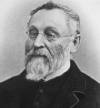THE HOMOEOPATHICIAN.

[From a lecture, “Who is a Homoeopathician,” delivered before the Hahnemannian Institute, Philadelphia, Feb. 17th 1865, by Adolph Lippe, M. D., Professor of Materia Medica at the Homoeopathic Medical College of Penn. Published by order of the Institute 8vo. pp. 26. King and Baird, Printers]
[The question “Who is a Homoeopathician,” has been discussed in our pages during the past year. Nowhere have we seen so clear, eloquent and liberal a statement as the following, to which we would gladly give the widest currency. - Eds.]
We have shown how Homoeopathy was developed, what belongs to it essentially, and what therefore, belongs also indispensably to the Homoeopathician. As all things have some characteristics by which we can know and discern them from all other things, we will endeavor to point out clearly, distinctly, and strongly, the characteristics of the Homoeopathician and the non-Homoeopathician, to which latter class belong of course all those who are not of the first-mentioned class, no matter by what name they call themselves.
A Homoeopathician speaks with the highest veneration of Hahnemann, of his writings, acquirements, genius and honest uprightness; of his superior gift of observation, and success in applying his new method of cure with far better results than his pupils through his most intimate knowledge of the Materia Medica which he created. The older the student the more he admires the genius of the master, for he knows him better and trusts him more the longer he associates himself with his writings, gradually becoming identified and enabled to follow him by experiment.
The non-Homoeopathist speaks disdainfully of Hahnemann; he calls him a man of straw, a visionary: declares him unreliable in his observations, his Materia Medica a mass of chaff, perfectly useless unless well sifted; his system he terms unscientific and ridiculous, in need of being modified, remodeled, or exploded. The less he knows of it the more fault he finds with it.
The Homoeopathician treats the patient.
The non-Homoeopathist treats diseases by their names. The Homoeopathician makes Pathology and all other collateral branches of the science of medicine subservient to the law of cure.
The non-Homoeopathist makes the law of cure subservient to Pathology, and vainly looks for specifics in specific diseases; as for instance: China for intermittent fever, Crotalus for yellow fever, Iodide of Mercury for diphtheria, etc.
The Homoeopathician administers one dose of medicine at a time, and never repeats that medicine or gives another until this one dose has exhausted its effects; because he knows well the effects of his medicines.
The non-Homoeopathist administers a mixture of medicines or alternates them; he never allows one dose of medicine to exhaust or even develop its effects, for he knows nothing accurately about the effects of any of his medicines.
The Homoeopathician is liberal, and contends that the whole scale from the crude natural substances up to the higher and highest infinitesimals should be open to the choice and the practice of every sensible and candid person.
The non-Homoeopathist is illiberal, and contends for appreciable quantities, sneering at the attenuating process and declaring it simply an absurdity.
The Homoeopathician generally administers small doses, believing in potentization; he knows by the experiment that Hahnemann's discovery of the development of medicinal and curative powers by potentization is true, and he decreases his dose in the same proportion as he increases his knowledge of the Materia Medica.
The non-Homoeopathist ridicules the pellet; he defiantly demands palpable doses; if unsuccessful, he never admits his ignorance of medicines but requires still larger doses; he does not see medicinal aggravations from his over-doses, but talks learnedly of the changed pathological conditions; in his hands the searing-iron, the caustic, the fly-blister, the scissors and the knife become blessings of no small virtue and of much more importance than the cultivation of the knowledge of the Materia Medica, which he despises through his dread of labor; he does not consult it, for he could not understand it; he boldly asserts that sleeplessness is cured by Opium in large doses and in this manner he betrays complete ignorance of physiology.
The Homoeopathician when he relates successful cures, enumerates at first all the symptoms discovered in the patient and at once it is apparent that he has well examined the case; he next gives the remedy, and states what characteristic symptoms demanded the choice of this remedy in preference to all others; the communication, so made, carries with it the assurance of truth and is instructive.
The non-Homoeopathist claims to have found the specific medicine or medicines for the specific disease or pathological conditions; he gives no reason but makes mere assertions and no instruction is gained by them; the credulous and ignorant only will follow his example-to fail.
The Homoeopathician is consistent and true to himself and to the fundamental principles he has accepted in the formula, and, as a foregone conclusion, he cures.
The non-Homoeopathist is inconsistent, true to no principles; having none, he contends for empiricism, and his occasional cures are accidental occurrences.
The Homoeopathician represents the true democratic principle in the healing art; he courts inquiry and lays facts before the people by which they may judge of the validity of his claims to superiority.
The non-Homoeopathist is tyrannical, denies the people the right of inquiry, lays no facts before them and dictates to them what they should believe.
The Homoeopathicians accept the formula as Hahnemann gave it; their motto is :
In certis unitas, in dubiis libertas, in omnibus charitas.
DOCUMENT DESCRIPTOR
| Source: | The American Homoeopathic Review Vol. 04 No. 11, 1865, pages 496-498 |
|---|---|
| Description: | The Homoeopathician. |
| Author: | Lippe, Ad. |
| Year: | 1865 |
| Editing: | errors only; interlinks; formatting |
| Attribution: | Legatum Homeopathicum |

